Let’s get one thing straight: Prospecting isn’t the glamorous part of sales. It’s not where you close deals, earn high-fives, or ring the gong. But if you skip it or do it half-heartedly, none of those other moments happen.
I’ve done over 11,000 cold calls and booked hundreds of meetings. I’ve helped founders land their first five clients and enterprise reps break into global accounts. And across every industry, one truth holds up: Consistent prospecting is the lifeblood of the pipeline.
This guide isn’t theoretical. It’s a battle-tested playbook full of what actually works, from sharpening your targeting to choosing the right tools, crafting emails that get replies, and building daily prospecting habits that drive results. Whether you’re a solo founder or a tenured AE, if you want to prospect like a pro, this is for you.
Let’s dig in.
Table of Contents
- What is prospecting?
- Why is sales prospecting important?
- How to Prospect Effectively
- Sales Prospecting Skills
- Sales Prospecting Tips
- Sales Prospecting Tools
- Sales Prospecting Process
- Outbound vs. Inbound Prospecting
- Sales Prospecting Questions
- Prospecting Email Examples
- Prospect Marketing
What is prospecting?
Prospecting is the process of initiating and developing new business by searching for potential customers, clients, or buyers for your products or services.
Prospecting is the front line of every great sales engine. It’s the work we do before the deal, when there’s no pipeline, no momentum, and no reply yet. It’s the process of identifying the right people, starting the right conversations, and opening doors that lead to revenue.
But here’s what I’ve learned after years of outbound: Effective prospecting isn’t about spray-and-pray lists or robotic outreach. It’s about relevance. You’re not just looking for anyone with a title; you’re looking for real people with real problems you can solve. And that means combining strategy, tools, and a lot of discipline to consistently surface high-fit leads and spark meaningful engagement.
Done right, prospecting doesn’t feel like an interruption. It feels like insight delivered at the right moment.
Why is sales prospecting important?
Because no matter how great your product is, it won’t sell itself — not in this market. Prospecting is the proactive engine behind revenue. It’s how you stop waiting for leads and start creating opportunities.
When I’ve skipped prospecting, I felt it in the pipeline two weeks later: fewer calls, fewer closes. But when I stay consistent, I don’t just fill the funnel — I fill it with people actually likely to buy. According to RAIN Group, top performers who prospect consistently generate 2.7x more meetings than their peers. That’s not luck, that’s intent paired with execution.
Prospecting also gives you a strategic edge: You’re not just reacting to inbound interest. You’re setting the tone, identifying fit, and creating value before your competitors even get a chance.
Lead vs. Prospect
Let’s clear up one of the most common misunderstandings in sales prospecting: the difference between a lead and a prospect. I’ve seen even experienced reps confuse the two, and it matters more than most people think.
A lead is anyone who’s shown some kind of interest. Maybe they downloaded a whitepaper, visited your pricing page, or signed up for a webinar. But at this stage, they’re still a question mark. You don’t know if they’re the right fit, or even seriously considering a purchase.
A prospect, on the other hand, is a lead that’s been qualified. That means you’ve done your homework: checked the company size, role relevance, industry alignment, or maybe even identified a problem your product could solve. You’re not just guessing anymore. You’re reaching out with intent.
Here’s how I think about it: A lead is a name. A prospect is a possibility.
Let’s say you sell workflow automation software for mid-sized logistics companies. A high school student downloading your ebook on time management? That’s a lead. But the operations director at a 500-person logistics firm who opened three of your emails and visited your product tour page? That’s a prospect worth your time.
Understanding this difference is what separates spray-and-pray sellers from consistent closers. Your prospecting time should focus on the latter. That’s how you build a reliable, scalable pipeline without burning out.
How to Prospect Effectively
Prospecting isn’t about blasting messages or chasing anyone with a pulse. It’s about being intentional. Before I ever reach out, I ask myself: Is this person the right fit? Do I have a reason to contact them beyond just hitting a quota? I don’t rely on templates or mass-blast tactics — I personalize every message based on real signals, such as a hiring spree, funding news, product launches, or even something they posted online.
I’ve learned that the strongest responses come from outreach that feels like a conversation already in motion, not a pitch out of nowhere. That means showing I’ve done my homework, being brief, and making the value obvious in the first few lines. And once I send that first message, I don’t stop there. I revisit what worked, iterate, and optimize constantly.
Effective prospecting is less about hustle, more about precision. It’s the art of relevance: reaching the right people, at the right time, with the right message.
1. Research your prospect and their business to gauge whether you can provide value.
I’ve never believed in blind outreach. If you’re guessing, you’re losing. Real prospecting starts with context, not a pitch. Before I ever hit send or pick up the phone, I immerse myself in the prospect’s world. What do they sell? Who do they serve? What’s changed recently? What’s broken? These are the questions that drive everything I do.
I treat the research phase like reconnaissance before a mission. I’m scanning LinkedIn for role changes or hiring sprees that signal growth. I’m checking the company’s blog or newsroom to understand what’s top of mind for their leadership. I’ll even look at Glassdoor reviews if I’m trying to get a read on internal culture or operational friction. And if I see they’ve just raised funding or adopted new tech, that’s a signal, not just of opportunity, but of timing.
But here’s the trick most reps miss: I’m not just collecting data, I’m connecting dots. I’m looking for alignment between their strategic priorities and the problems I know how to solve. If I can’t find that overlap, I don’t reach out. Because when you reach out without relevance, you erode trust before you even get a reply.
Prospecting is not about volume. It’s about precision. And that precision starts here, with the discipline of researching like someone whose time actually matters. Because it does. And when you treat your prospect’s time with that level of respect, you earn the right to have a real conversation.
2. Prioritize your prospects based on their likelihood of becoming customers.
Not all prospects deserve the same amount of your energy. I learned that the hard way early in my career, spending hours chasing logos I thought were impressive but had no urgency, budget, or pain. Just because someone looks like your ideal customer on paper doesn’t mean they’re ready to buy — or even willing to talk. So I stopped treating every lead equally and started qualifying like my calendar depended on it.
Prioritization isn’t about guesswork; it’s about pattern recognition. I look for signals that indicate buying intent: recent funding, job postings in key departments, LinkedIn activity from decision-makers, or a tech stack change that aligns with our solution. I tag these prospects as “active,” and they go to the top of my list. If a company fits our ICP but shows no movement, I keep them warm in a nurture sequence but don’t spend time crafting custom messaging just yet.
Scoring Potential Prospects
Let’s face it, not every lead deserves the same amount of attention. When your pipeline fills up, your time becomes your most valuable asset. That’s why having a prospect scoring system isn’t just “nice to have” — it’s your filter for clarity, speed, and revenue.
I’ve built and rebuilt lead scoring models for years, across startups and enterprise teams, and the same truth always surfaces: Activity without prioritization leads to burnout. You end up chasing shadows while the real opportunities slip through the cracks.
So, here’s how I approach scoring potential prospects, not in theory, but in the trenches.
Assign weight based on your current GTM priorities.
Start by asking: What matters most to this campaign or cycle? Some teams prioritize company size or budget, while others focus on timing signals or buying behavior. For example, if I’m selling a complex SaaS platform, I’ll give more weight to “tech stack compatibility” and “team size.” But if it’s a limited-time launch, I’ll shift weight toward “intent” and “urgency.”
I typically use three buckets:
- Fit (Firmographics). Industry, company size, role, location, and tools used.
- Intent (Behavioral). Page visits, email opens, event attendance, engagement.
- Timing (Trigger events). Funding rounds, job changes, hiring, product launches.
Each gets a percentage weight. One campaign might look like: 50% Fit, 30% Intent, 20% Timing. Another might flip that.
Score prospects on a 0–100 scale per signal.
Next, I rate each prospect manually or with automation. If a prospect perfectly fits our ICP, I’ll score them 90+ on Fit. If they’ve opened three emails and clicked a case study, they might score 70 on Intent. If they’re hiring for a role related to our product, that’s a hot timing signal, maybe an 80.
Then I multiply those scores by the weight of each category.
Example:
- Fit: 90 × 0.5 = 45
- Intent: 70 × 0.3 = 21
- Timing: 80 × 0.2 = 16
Total Score: 82/100
Anyone scoring above 75 becomes a priority. That’s my “A-list.” I focus most of my outbound energy there, crafting personalized messages, using multichannel outreach, and looping in sales engineers or content assets if needed.
Don’t just rank — rethink your motion based on the score.
Here’s the part most people miss: Scoring isn’t just about who to call first, it’s about how you engage.
If a prospect has high intent but low fit, maybe they’re a partner, not a customer. If someone has a great fit but no urgency, I’ll drop them into a nurture track. If they’re red-hot across all three signals, I’ll move fast, even looping in leadership if necessary.
Scoring gives me a map. Not just a list of names but a game plan.
Automate without losing the human touch.
You don’t need to run this on spreadsheets forever. Tools like HubSpot, Apollo, or even basic CRM logic can handle scoring models with custom fields and workflows. But always layer it with human judgment.
Some of my best clients had “low” scores at first, but a quick LinkedIn post or referral turned them into six-figure deals. So treat the score as a compass, not a cage.
3. Prepare a personalized pitch for each prospect.
There’s a reason spray-and-pray messaging doesn’t work: It treats humans like inboxes, not people. When I build a pitch, I don’t start with my product. I start with the person. Who are they? What keeps them up at night? Where do they sit in the org, and what do they stand to gain or lose?
I’ve learned the hard way that if your message feels like a template, it becomes a template. Ignored. Deleted. Forgotten.
So before I craft a pitch, I spend time earning the right to reach out. Here’s how I do it in practice.
First, I research beyond the basics. Yes, I look at LinkedIn, but I also check recent press, funding announcements, product launches, or hiring trends. If their team just rolled out a new integration, I’ll frame my message around accelerating adoption. If they’re scaling rapidly, I’ll speak to operational leverage.
Second, I map their role to their likely KPIs. For a VP of sales, I might mention pipeline velocity. For a head of ops, I might talk about time-to-productivity. Every pitch connects my solution to their scoreboard.
Third, I look for personal signals: podcast interviews, shared connections, even past companies. One time, a CRO replied because I referenced a podcast he did four years ago. “Nobody’s ever mentioned that one,” he said. “Let’s talk.”
Finally, I anchor the pitch in a trigger. Maybe they downloaded a resource, or maybe a competitor just launched a new feature. These moments turn cold outreach into warm timing.
The structure I use is simple:
- Open with relevance — why this message is for them.
- Mirror their reality — show you understand their context.
- Make it brief and valuable — one idea, one outcome, one ask.
Because when you respect someone’s time and speak directly to their world, the pitch doesn’t feel like a pitch. It feels like a partnership waiting to happen. That’s how modern prospecting wins.
4. Craft the perfect first touch — and ensure you’re helping, not selling.
The first touch is where most reps go wrong, not because they’re bad at sales, but because they jump the gun. I’ve seen great products ignored simply because the outreach felt like a pitch, not a conversation. In a world flooded with templates and automation, what cuts through isn’t persuasion. It’s presence.
When I reach out for the first time, my only goal is to start a conversation that makes sense for them. Not for my quota or my calendar. For them.
Here’s what I’ve learned after thousands of cold calls and cold emails:
- Lead with context, not credentials. You’re a stranger. The only way to earn their attention is to quickly make it clear that you’ve done your homework and you’re here to help, not to sell. Start by referencing something recent: a product launch, a podcast quote, a press release.
- Talk about them, not your tool. I like to mirror the buyer’s reality before I mention anything about my solution. Instead of “We help teams automate outreach,” I’ll say, “I noticed you’ve doubled headcount in sales, curious how that’s impacting your pipeline speed.” The shift is subtle, but powerful.
- Offer insight, not a meeting. Your first message should give, not ask. Share a resource, highlight a blind spot, or offer a quick rundown of something relevant. One of my best-performing emails offered feedback on a broken CTA on their site. That earned the reply — and the meeting.
- Keep it human. Be normal. Drop the corporate tone. If I wouldn’t say it out loud, I don’t write it in an email. Adding a “Saw this and thought of you” or a quick compliment about a recent announcement can go a long way.
Prospecting done right doesn’t feel like selling. It feels like solving. And the best first touches don’t sound like outreach. They sound like someone who actually gives a damn.
5. Iterate on your prospecting process to understand what you can improve.
Prospecting isn’t a script. It’s a system in motion, and if you’re not reviewing it, you’re just guessing. My 10,000+ cold calls and hundreds of outbound campaigns have taught me that the reps who win consistently aren’t the ones with the most charm. They’re the ones who debrief the playbook after every play.
That means I don’t just hit send and move on. I stop and ask: What worked here? What didn’t? Did the subject line get opens? Did the CTA create friction? Was the timing off? Did I ask a question that sparked curiosity or one that got ignored?
Every touchpoint gives you data, whether that’s in your CRM, your email tool, or your gut. Use it.
What I do weekly is review my activity like an analyst. I look at response rates, yes, but I also read replies like a buyer. Where did I sound robotic? Where was I too vague? Where did I actually resonate?
Improving prospecting isn’t about changing everything. It’s about testing one thing at a time: a tighter hook, a new follow-up angle, a different opening line. Then, let the results guide you.
Because the truth is, you won’t know what works until you’ve done enough of what doesn’t and paid close enough attention to notice the difference.
Sales Prospecting Skills
1. The Ability to Identify Target Accounts
Daryll Dorman, sales manager at AllMax Software, says, “To be effective prospectors, sales reps need to understand what their target account looks like. You can analyze your current customer base to figure out the best size using filters from HubSpot.
“From there, you should use tools like LinkedIn to gather the different stakeholders you’ll need to work with. Tailor your conversation to the role you are targeting and be consistent. You will achieve success before you know it!”
2. Effective Listening Skills
Kristy Galea, director of sales at Cadence SEO, says, “One skill sales reps need to develop is effective listening — I see so many reps prepare decks to pitch, but if they are not listening to the pain points of the prospect first, then the fully-prepared deck has zero value.
“Effective listening, understanding, and building value around what the buyer is communicating is essential in building the relationship and winning the business in a positive way.”
3. Product Knowledge
Mike Sadowski, founder and CEO of Brand24, says, “For me, the most important one is product knowledge. You’ve got to know your stuff inside and out. It’s not just rattling off features, but understanding how you solve real problems for customers. When you reach out, you need to quickly explain how you’ll add value to their business.”
4. Time Management
Sadowski also says, “Time management is also key. Prospecting is a numbers game, and you’ve got to juggle multiple leads at different stages. It’s about finding that balance between quantity and quality. You can’t spend all day on one lead, but you also can’t just blast generic messages to thousands.”
5. Integrity
Dennis Sanders, founder of Burning Daily, says, “I still believe that integrity, as a virtue, is your most potent weapon. It is a bedrock upon which lasting client relationships are built and the cornerstone of sustainable success for you in your sales career.
“Any amateur sales rep can chase quick wins through half-truths and exaggerations, but those who are honest about their product or services can create long-term partnerships of trust with their prospects.
“One should view honesty not as a constraint but as a liberating force. When you’re transparent, you’re not just selling a product; you’re selling trust. And trust in business is the most valuable currency. Your word is your bond. Break it, and you’re not just losing a deal — you’re poisoning the well of future opportunities.”
6. Empathy
Raviraj Hegde, SVP of Growth & Sales at Donorbox, says, “Empathy is critical. Understanding a prospect’s pain points and seeing the world through their eyes helps build trust. When I coach sales teams, I emphasize the importance of active listening. By truly hearing what the prospect is saying — and sometimes what they’re not saying — a rep can tailor their approach, making the conversation feel more like a collaboration than a pitch.”
7. Perseverance
Michael Nemeroff, CEO and co-founder of Rush Order Tees, says, “Unyielding perseverance is a must. If they haven’t asked you to stop calling yet, you haven’t called them enough. Prospecting is by far the hardest part of the job because you hear ‘no’ all day long. You can’t let those responses slow you or emotionally deplete you.
“The very best in the business have a solid routine to help them control the negative influences in their lives. They might read, listen to podcasts, or find other ways to manage their stress and recharge their batteries so they can come back fresh each time after rejection.”
8. Learning From Feedback
Cesar Cobo, director of operations at Webris, says, “Successful sales reps excel at learning from feedback. Actively seeking out feedback from different sources, such as prospects, peers, or managers, can be a game-changer.
“Imagine a scenario where a sales rep receives constructive criticism from a prospect about their pitch. Instead of taking it personally, they use that feedback to tweak their approach, making future pitches more compelling and tailored.
“This openness to external insights allows them to refine their methods continuously, leading to improved engagement and conversion rates. Feedback isn’t just about identifying mistakes — it’s also about recognizing strengths. When managers or colleagues provide positive feedback, it reinforces what’s working well, enabling reps to double down on those strategies.
“For example, if a manager praises a sales rep for their excellent follow-up technique, the rep can make that a standard part of their approach. The constant loop of learning and adjusting makes a well-rounded, effective prospector who can navigate diverse sales scenarios with agility and confidence.”
Sales Prospecting Tips
Prospecting isn’t about grinding through a list. It’s about learning how to see what others miss. Over the years, I’ve found that what separates average reps from consistent top performers isn’t just effort: it’s strategy. The tips below aren’t theoretical. They’re battle-tested habits I’ve used (and taught) to get more replies, book more meetings, and keep momentum in even the toughest markets.
Let’s break them down.
1. Look at your prospects’ career pages.
When I’m building a prospecting list, I treat a company’s careers page like a gold mine. Why? Because hiring tells you exactly where the business is investing. It’s one of the fastest ways to map their priorities, before they tell you in a call.
Let’s say I’m selling a sales enablement platform. If I see five open roles for RevOps, SDRs, and enablement managers, I already know they’re scaling. That’s a cue to tailor my message toward productivity gains and faster ramp times, not just features. On the flip side, if a startup is hiring for compliance or legal, I might shift the narrative toward risk mitigation and audit readiness, even if the product angle stays the same.
The job page gives you something most reps miss: context. It tells you what they care about now, not just what’s on their LinkedIn or funding round.
And if you’re selling into public companies, don’t skip their 10-K report. I’ve used it to spot risk factors, budget concerns, or expansion strategies that helped me close the gap between “nice-to-have” and “need-to-act-now.”
The takeaway? Prospecting isn’t just outreach. It’s research that leads to resonance.
2. Use the GPCTBA/C&I sales qualification framework.
When it comes to prospecting, I’ve seen too many reps fall into the same trap: chasing anyone who replies. But activity isn’t progress if it’s pointed at the wrong target. That’s where qualification frameworks like GPCTBA/C&I come in, not just to filter leads, but to uncover fit, urgency, and alignment before you burn cycles.
Here’s how I approach it in practice:
- Goals. What are they trying to achieve this quarter? If I can’t tie my solution to a revenue-driving initiative, it’s a yellow flag.
- Plans. Are they flying blind or following a roadmap? Plans give me a preview of how my solution might fit — or clash — with their strategy.
- Challenges. This is where the real gold is. I’m not just looking for problems — I’m looking for prioritized pain. Bonus points if I hear phrases like “we’ve tried before” or “we’re losing time here.”
- Timeline. Are they evaluating for now, next year, or never? Timeline helps me adjust my follow-up pace and pipeline forecast.
- Budget & Authority. These come together. I ask who owns the budget, who owns the decision, and how they justify spending. If they can’t answer, I know I need to move up.
- Consequences & Implications. This is where the story deepens. What happens if nothing changes? What if it works? Framing the emotional and operational stakes turns a nice-to-have into a need-to-move.
I’ve used this structure in thousands of discovery calls, not as a checklist, but as a compass. When you truly qualify with GPCTBA/C&I, you stop guessing who your buyer is. You know. And that makes every next step — demo, proposal, close — land sharper and faster.
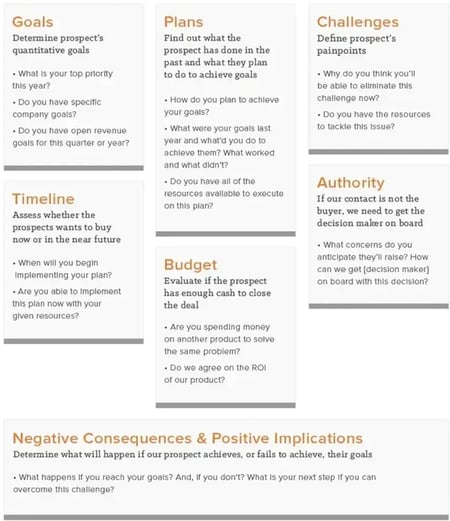
3. Classify prospects with ratings.
Not all prospects deserve the same energy. One of the most impactful shifts I made in my early sales career was learning to rank intent against fit. A prospect clicking your email twice doesn’t mean they’re close to buying, just curious. That’s why I build my prospecting system around three tiers: high, medium, and low fit. It helps me move fast without wasting firepower on leads that were never serious.
Here’s how I break it down:
- High Fit prospects check most of the ICP boxes. They’ve got the right company size, tech stack, role, and pain. You’re speaking to a decision-maker or someone one introduction away. These are worth your best sequences, personalized research, and real-time outreach. They don’t just look good; they feel like buyers.
- Medium Fit means there’s potential, but something’s off. Maybe the timing is vague, or you’re still one level below the economic buyer. These leads are worth nurturing, but not obsessing over. Keep the cadence steady, but don’t overinvest too early.
- Low Fit prospects are usually tire-kickers, low engagement, or completely misaligned. If you’re still following up with these after five touches, you’re not prospecting, you’re procrastinating. I tag these for automated drips or circle back if market signals shift.
This kind of rating system isn’t about labeling people; it’s about preserving your focus. In prospecting, effort isn’t the metric. Effectiveness is. So spend more time where fit meets urgency, and let the rest follow your process, not your emotions.
4. Subscribe to your prospects’ blogs.
Too often I see reps sending templated emails to prospects who literally just wrote a blog post that could have been the perfect conversation starter. If your prospects are publishing content, and especially if they’re in marketing, product, or leadership, you have a golden window into how they think, what they care about, and where their pain is surfacing.
When I’m preparing for outreach, I subscribe to their blog or company newsroom, but I don’t just let unread articles pile up. I batch time every Friday to scan for updates from my top-tier accounts. If something jumps out, like a product launch, a big hiring push, or an insight-rich post from a VP, I take note.
But here’s the trick: I don’t quote the blog back at them like I’m doing homework. I use it as context to show I’ve done my due diligence and to ask a smarter question. Something like, “I saw your team’s rolling out new integrations, how are you planning to handle X?” It turns cold outreach into warm relevance.
You don’t need to read 50 posts. You just need one good sentence that proves you care enough to learn before you sell. That’s what separates reps who get ignored from the ones who start real conversations.
5. Keep track of your prospects on X (formerly Twitter).
I don’t follow my prospects on X just to see what they had for lunch. I follow them to read between the lines. Because the moment a VP starts sharing company news, team wins, product launches, or hiring plans, that’s not just content, it’s a signal.
Instead of relying on alerts or trying to dig through a busy timeline, I build private X Lists. One for high-priority targets, one for long-term nurtures, and one for partner influencers. That way, I’ve got curated micro-feeds that help me track real-time context without falling down the doomscroll rabbit hole. Alternatively, you could use a social media management tool.
Some of my best cold emails didn’t start with “I’d love to connect.” They started with: “I saw your team just hired five new reps. I’m curious if ramp time is top of mind right now.” Because when your outreach ties directly into what your prospects are already thinking about, you’re not interrupting, you’re aligning.
You don’t need to comment on every post or try to be cute in the replies. Just observe, listen, and let those signals inform your next move. In a noisy sales world, relevance is your edge, and X gives you a live feed of what matters most to your buyers. Use it.
6. Batch prospecting sessions.
Prospecting isn’t hard because it’s complicated; it’s hard because it requires focus. And in a world of Slack pings, open tabs, and endless scroll, context-switching is your real enemy. That’s why I batch all my prospecting into deep-focus sprints.
Here’s how I do it. I block out 90-minute windows — just me, my lead list, and zero distractions. No inbox. No calls. Just outbound. I warm up with research, knock out first-touch emails, log the CRM, and send quick LinkedIn DMs all in one burst. Then I stand up, stretch, and walk away. That reset matters more than people think.
By batching prospecting sessions, I eliminate friction, build momentum, and get into a flow state. And honestly? It makes the process less intimidating. Instead of chasing “inbox zero,” I chase quality touches in focused blocks. That rhythm (repetition, pause, repeat) is how I’ve consistently filled the pipeline, quarter after quarter. It’s not just about the reps. It’s about how you structure them.
7. Use a healthy mix of email and phone communication.
In my experience, the best prospecting strategies don’t favor email or phone; they integrate both like tools in a well-balanced kit. Some reps get overly comfortable behind their keyboard. Others over-rely on cold calls and burn out fast. But if you want consistent results, you need to blend both based on timing, context, and buyer behavior.
I use email for scale and structure: initial touches, value-driven resources, and follow-ups. It helps me document everything, build a paper trail, and reach buyers who live in their inboxes. But the moment I sense hesitation, or if I’ve sent two emails without traction, I pick up the phone. Not to pitch, but to connect. Voice adds tone, urgency, and human nuance that email can’t match.
Here’s what’s worked for me: I lead with a short, personalized email. Then I follow up with a call referencing that message, something as simple as, “Just wanted to make sure you saw my note.” That one-two punch boosts reply rates and opens doors that a single channel wouldn’t.
To decide which channel to use (and when), I keep this mental cheat sheet in mind.
Email Communication: What Works and What Gets Ignored
What Works | What Backfires |
You get to show value on the prospect’s timeline. It’s non-intrusive and scalable. | Email inboxes are digital war zones. If you don’t stand out fast, you’re toast. |
Prospects can click, forward, research, and reply when they’re ready, on their terms. | Emails vanish. Literally. Either into spam, into oblivion, or into “I’ll get to it later” (which means never). |
Great for looping in multiple decision-makers and building an internal case. | You’ll often need to follow up more times than you’re comfortable with before you even get a “maybe.” |
Phone Communication: The Underrated Power Move
Why It Works | Where It Falls Flat |
Real-time convo = real connection. You get clarity, tone, and momentum — all in seconds. | Cold calls can trigger resistance. Wrong timing or no context? You’ll get shut down fast. |
It cuts through the noise. Your voice competes with no one in the inbox. | If unscheduled, it can feel like you’re barging in. You need tact and timing. |
You get answers faster. Less “back and forth,” more “let’s set a time.” | Many won’t pick up. Voicemails? Most get skipped unless they’re sharp and relevant. |
In today’s noisy sales world, the best way to stand out is to meet prospects where they are, sometimes in their inbox, sometimes in their ears. The key is knowing when to switch gears.
8. Use the BASHO sequence for emails and calls.
Sales leader Jeff Hoffman pioneered an approach known as the BASHO sequence, which advocates for the following combination of voicemails or emails to build connections with prospects.
- Voicemail / Email: Wait for 24 hours.
- Voicemail / Email: Wait for 48 hours.
- Voicemail / Email: Wait for 72 hours.
- Voicemail / Email: Wait for five days.
- Breakup Voicemail / Email.
Alternate between voicemail and email, with unique messaging each time. This technique allows prospects to consider your offer, conduct their own research, and respond at a time that is convenient for them.
But, how do you leave a voicemail or send an email that prospects will actually want to respond to? Let’s dive into the do’s and don’ts of each communication method below.
Tips for Writing a Warm Email
If you’re looking to send a first-touch email that gets opened, here are some essentials to include:
- Engaging subject line. The subject line has to pique the prospect’s interest while avoiding cliché hooks.
- Personalized opening line. You should begin your cold email by saying something about the prospect, not about your business. After all, this process is about finding the prospect’s pain points and determining a way to add value to their business.
- Clear connection. Now, you have to make a connection. In your opening, the prospect learned why you’re reaching out to them, but now they need to know why they should care about what you do.
- Concrete call-to-action. Suggest a concrete time to connect or ask a specific question to make it clear that the ball is in their court. Some of my favorite lines are: “Do you have ten minutes to catch up tomorrow?” or “Are you available for a 30-minute call on Tuesday between 9 and 11 AM?”
You can also try sending a calendar invite instead of an email to get straight to the point. In the description section, you can type up a personalized message.
Author of the award-winning sales book Snap Selling Jill Konrath suggests another helpful approach: You can schedule a short, five-minute meeting to get your foot in the door with prospects whose calendars are particularly swamped.
Tips for a Prospecting Call
If you decide to call a prospect, I’d suggest following this basic structure for the call:
- Establish rapport. Don’t shy away from personal conversations, like asking how a prospect’s weekend was or what team they’re rooting for in the game tonight. These intimate touches can help you develop more meaningful relationships with prospects and enhance your likability, in turn (hopefully) making them more likely to buy from you.
- Leverage pain points. Dive into their pain points during the call. By the end of the conversation, you should know all of their primary business challenges and the underlying causes associated with them. Once you have an understanding of these key issues, you can better position your product or services to address those pain points.
- Create curiosity. Ask more than you tell. This conversation is about them, about understanding their needs and problems. The less you talk about your business and product, and the more you ask questions about them and their business, the more your prospect will be interested in hearing the final pitch.
- Wrap it up. Find a time 24–48 hours after the discovery call to book a follow-up meeting. Try this line: “Would you have 30 minutes to follow up this week? My colleague, John, will join us — he’s an expert in X, Y, Z. My calendar’s open; what time works best for you?”
9. Follow-up after a closed-lost deal.
Rejection is never fun, but it can be useful. Bryan Kreuzberger, founder of the lead generation company Breakthrough Email, sends a follow-up email if prospects respond with a rejection. The purpose of this email is simple: Learning. You can use a rejection as an opportunity to better understand how you can improve your sales techniques by following this template:
Hi [prospect name],
Thanks for your email. I just closed your file. I have a quick question as a final follow-up. Why aren’t you interested? Was it something I did?
If there is any way I can improve, let me know. I’m always looking for input.
Thanks for your help,
[Name]
I’ve found that sending a simple email like this can make a big difference, helping sales teams identify flaws in their processes while also maintaining a positive relationship with the prospect.
10. Thoroughly understand your vertical.
If there’s one shortcut to being taken seriously during prospecting, it’s speaking the language of your buyer better than they do. I’ve learned that real credibility doesn’t come from slick scripts or clever hooks but from understanding the world your prospect lives in. The pain points they obsess over. The KPIs they chase. The internal politics they navigate.
Whenever I step into a new vertical, whether it’s fintech, SaaS, manufacturing, or medtech, I treat it like I’m joining their team. I read their industry journals, analyze their competitors, and even follow their influencers on LinkedIn to get a sense of what they’re celebrating, worried about, or trying to fix. I’m not prospecting into a “market.” I’m stepping into their day-to-day reality.
Here’s what I focus on.
I dive deep into how their business model works, how decisions are made, and what typical budget cycles look like. I look for regulatory pressure points, common operational bottlenecks, and the specific outcomes that matter most to their team. Once I know that, I can show up with solutions that actually map to their world, not generic fluff.
It also helps to mirror their language. I make a point to use their acronyms, frameworks, and metrics. When you say “ARPU” to a SaaS CFO or “yield loss” to a plant director, you’re not just signaling competence, you’re building instant trust. It shows you’ve done your homework. You’re not just trying to sell to them, you’re trying to solve with them.
Bottom line? Prospecting without understanding your vertical is like showing up to a job interview without knowing what the company does. The more fluent you are in their space, the more relevant and referable you become.
11. Ask for referrals.
According to HubSpot’s recent survey of over 1,000 sales professionals, 66% of salespeople say referrals from existing customers offer the best leads — and high-quality leads often become productive prospects.
By asking for referrals, you can generate a wider base of warmer, more easily convertible contacts, giving yourself a crucial leg up when prospecting. When an existing customer connects you with a referral, they’re essentially saying, “I think this person could stand to gain from your solution.”
In turn, you can go into engagements with these leads knowing they’re more likely than most cold contacts to consider your offering. You can also reference the customer who put you in touch with that lead when conducting your outreach — a solid conversation starter that helps you develop instant rapport.
So, how do you ask for referrals? Well, as obvious as this might sound, you just ask for them. After you convert a prospect into a customer, follow up with them and ask if they know anyone else who might benefit from your solution.
If they don’t know anyone straight off the bat, or if they are reluctant to hand out names right away, wait until they’ve enjoyed your product or service for a while. Then, when you know they’re happy with your offering, check in again.
Now that they’ve been a customer for some time, they might be more likely to put you in touch with some contacts who will be willing to hear you out. To sweeten the deal even more, you can also offer them some sort of incentive, like a discount or other promotions, in exchange for a referral.
With all of the steps and strategies involved in the prospecting process, you might find yourself spending a lot of time on menial tasks. Luckily, there are a number of sales prospecting templates and tools you can use to boost productivity and automate tasks.
Sales Prospecting Tools
You can select specific tools from this list to use independently, or you can use multiple in tandem. To determine your needs and gaps, consider which tools you currently use for prospecting. Then, experiment with the options below to discover which ones work best for your business.
1. HubSpot CRM
Pricing: Free plans are available
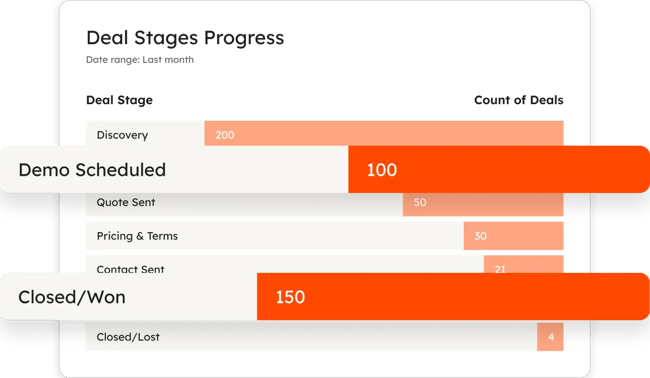
Best for: Accruing and applying data for detailed company insights.
The HubSpot CRM has a robust suite of features that can cover a range of your business’s needs — but when it comes to prospecting, HubSpot sets itself apart with its support of detailed company insights.
Your prospecting efforts won’t take you too far if they’re poorly informed, but sorting and applying relevant prospect information can be as frustrating as it is essential.
The HubSpot CRM automatically populates new contact, company, and deal records with details from its database of over 20 million businesses. All you need is a prospect’s corporate email address.
So, if you’re in the market for a solution that can streamline, simplify, and enhance your prospecting efforts by giving you a fleshed-out picture of who you’re selling to, the HubSpot CRM might be the way to go.
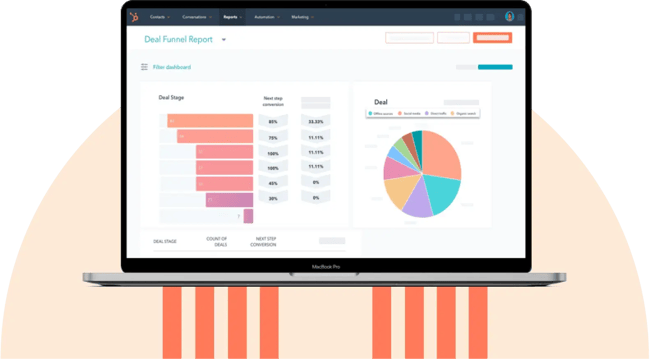
Key Features and Benefits
- Automatically populates business insights based on a database of over 20 million businesses.
- Offers a centralized location for easily sorting and tracking prospect details, including intel from sales calls, emails, notes, deal activity, lifecycle changes, and social media.
- Includes an accessible dashboard that lets you choose which information to display on your contact, company, and deal records (without any help from IT).
2. Hunter
Pricing: Free plans are available
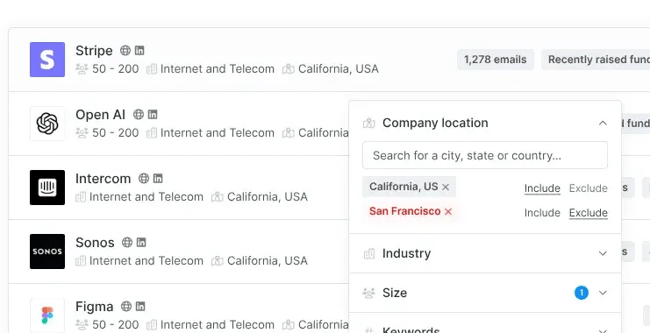
Best for: Aggregating email data for prospecting.
Hunter offers a unique resource to set email prospecting efforts in motion. Its solution allows users to quickly and easily translate web data into a list of email contacts, giving salespeople easy access to a solid base of targeted prospects.
Hunter boasts an impressive roster of customers — including Google, IBM, and Microsoft — and for good reason: It’s a solution that combines accessibility with powerful functionality. Virtually any salesperson can easily leverage it to verifiably identify and connect with almost any prospect.
Key Features and Benefits
- Enables you to search for prospects and find their email addresses by role.
- Helps you identify emails via common email formats used in the organization from dozens of possible combinations.
- Can produce email addresses either in bulk or individually.
3. Kixie
Pricing: Plans start at $35 per month
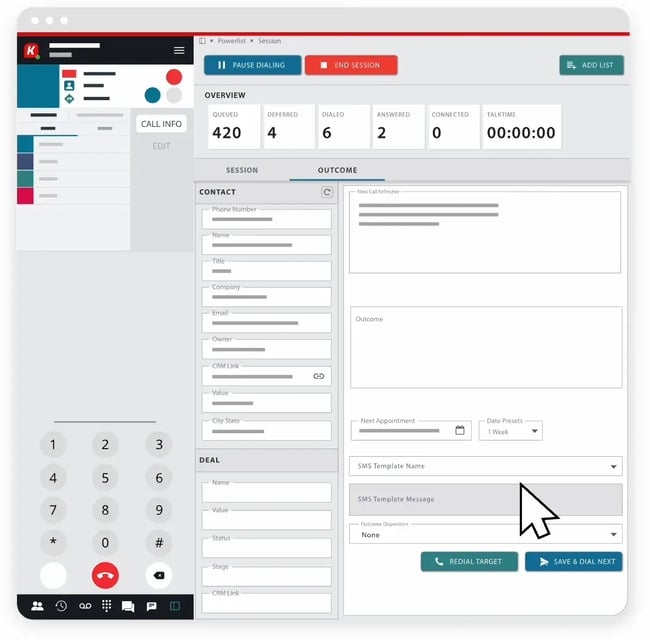
Best for: Reliable, easy-to-integrate calling and texting automation.
Kixie is one of the preeminent prospect outreach resources on the market. It’s a customizable business calling and texting platform that allows you to thoughtfully and effectively time and target your sales calls, letting you connect with the right prospects at the right time.
The software folds easily and seamlessly into your tech stack, and it can integrate with several high-profile platforms, including HubSpot, Slack, and Pipedrive.
It’s also one of the most accessible options in its space. In fact, I’ve found that virtually any user can quickly pick up and leverage the program without extensive training. So, if you’re looking for a streamlined, low-maintenance solution that lets you connect with your prospects exactly when they’re most likely to be receptive to your outreach, look into Kixie.
Key Features and Benefits
- Supports an extensive suite of integrations.
- Enables you to contact thousands of prospects in a single day.
- Easy implementation with minimal training required.
4. HubSpot Sales Lead Management & Prospecting Software
Pricing: Free plans are available
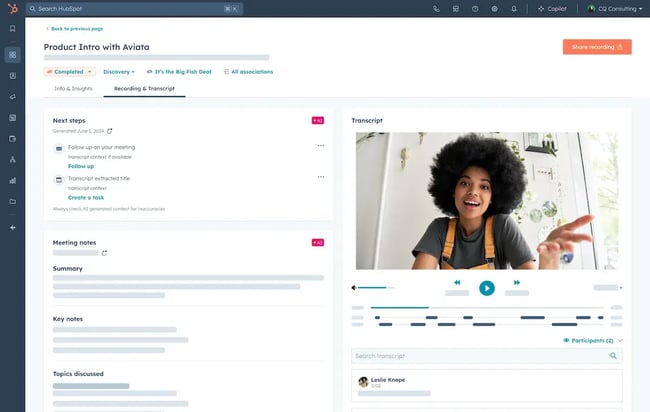
Best for: Establishing a baseline for a sound prospecting infrastructure.
HubSpot’s Sales Lead Management and Prospecting Software is a collection of resources that helps you refine and more effectively conduct your engagements with leads and prospects — and it covers a lot of bases.
This solution includes a conversation intelligence system that can give you perspective on how to best tailor your messaging, as well as automated email sequencing, customizable email templates, predictive lead scoring, and several other first-rate resources for better understanding and catering to your prospects.
HubSpot’s Sales Lead Management and Prospecting Software is essentially a one-stop shop that offers a foundation for effective prospecting.
If you’re looking for a suite of free resources that provide virtually everything you need to set your sales org up with a solid prospecting infrastructure, I definitely recommend checking out these resources.
Key Features and Benefits
- A range of resources, including conversation intelligence, email templates, email sequences, predictive lead scoring, and reporting.
- Ability to track and filter leads to identify viable prospects.
- Seamlessly blends with your tech stack.
5. SalesHandy
Pricing: Plans start at $7/month per slot
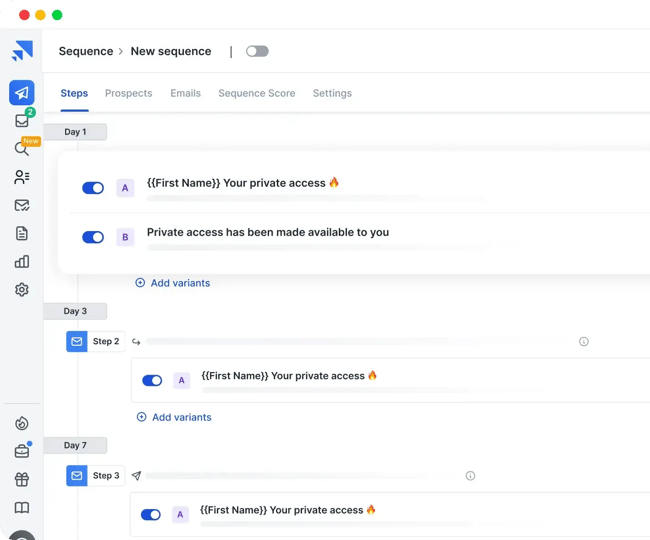
Best for: Sound, approachable cold email outreach.
SalesHandy is an outreach resource that allows you to reliably send thoughtful, effective, high-converting cold emails. The solution offers features like automated, multi-stage sequences for consistent follow-up — ensuring interested prospects don’t fall through the cracks.
The software lets you standardize your outreach strategy without sacrificing personalization, helping you tailor your subject lines and email copy to suit individual prospects (without too much legwork).
It also ensures that the content of your emails isn’t too robotic, letting you circumvent spam filters and deliver emails your prospects will actually read.
Ultimately, SalesHandy is a cold email solution with a robust suite of features that can help you reach out to prospects more effectively. If you’re looking to integrate a platform that can enhance how you connect with prospects into your tech stack, consider looking into SalesHandy.
Key Features and Benefits
- Automated follow-up for scheduling multi-stage email sequences.
- Merge tags that allow for personalization.
- Easy integration with your current email provider.
6. UserGems
Pricing: Plans start at $10k, pricing is usage-based
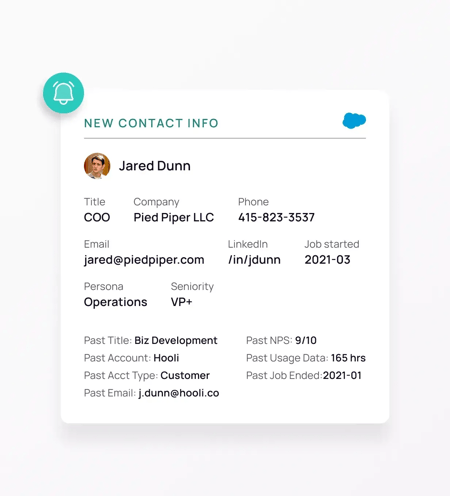
Best for: Capturing buying signals and automating the next steps with AI assistance.
Buying intent data helps reps understand and prioritize high-intent leads, cutting through the noise and focusing sales and marketing efforts on prospects who are actually ready to make a purchase.
UserGems helps revenue teams monitor their ICP accounts for buying signals to identify buyers most likely to convert. Then, it tells your reps who to contact, when, and why. Using those signals, it drafts emails, cold call scripts, and LinkedIn messages for your reps to review (or it sends them automatically for them).
By streamlining prospecting and workflows, reps can spend 90% of their time prospecting and selling instead of manual research and data entry. With UserGems, you’ll 10x your team’s performance and efficiency.
Key Features and Benefits
7. Crunchbase
Pricing: Plans start at $29 per user/month
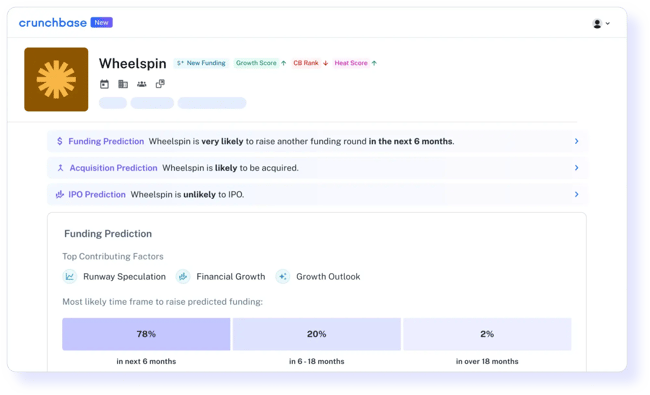
Best for: Screening and discovering businesses that fit your ideal customer profile.
Crunchbase is essentially a business intelligence gathering platform that lets you pull live company data to inform more targeted, effective prospecting. It lets you search for and pull information from a massive database of organizations, providing insight into individual companies’ characteristics and operations.
The platform gives users a picture of key elements of how a business functions and performs, including investment information, founding members, leadership profiles, mergers, acquisitions, news, and industry trends.
In this way, Crunchbase effectively centralizes and streamlines your prospect research efforts, providing you with valuable intel that can help you structure more thoughtful pitches and execute better-targeted outreach.
So if you’re looking for a solution that can both simplify and enhance how you understand your prospects, Crunchbase is definitely a strong option to consider.
Key Features and Benefits
- An extensive pool of live data on thousands of potential prospects.
- A filtering function that lets you pare down your searches based on ideal characteristics.
- Live tracking to keep tabs on key company events and developments.
8. Wiza
Pricing: Free plan is available with paid plans starting at $25 per month
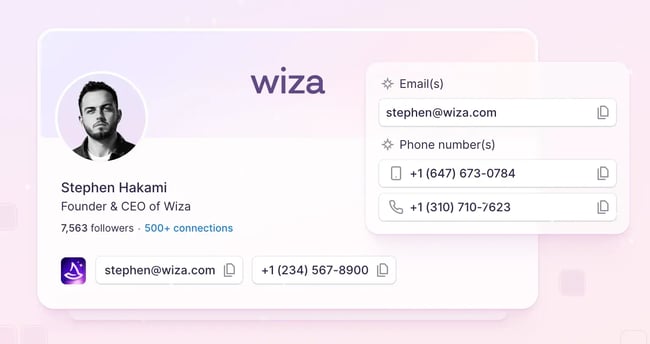
Best for: Finding real-time verified email addresses.
Wiza is a popular sales prospecting platform for sales, marketing, and recruiters. It is one of the only prospecting platforms that provides real-time email verification within the app, to ensure high levels of email accuracy and deliverability in your prospecting outreach. With Wiza, you can build and save email lists, then export them as CSV or sync them to CRMs, including HubSpot.
In addition to their prospecting platform, Wiza offers a free Chrome extension that allows you to view email and contact information while browsing LinkedIn profiles. This extension can also be used to export large lists with email addresses and phone numbers from filtered and saved searches in LinkedIn Sales Navigator and LinkedIn Recruiter.
Key Features and Benefits
- Search and discover real-time verified email addresses and contact info.
- Bulk export or integrate directly with popular tools like HubSpot, Outreach, and more.
- Free Chrome extension that provides emails while using LinkedIn, LinkedIn Sales Navigator, and LinkedIn Recruiter.
9. SalesIntel
Pricing: Contact for custom pricing
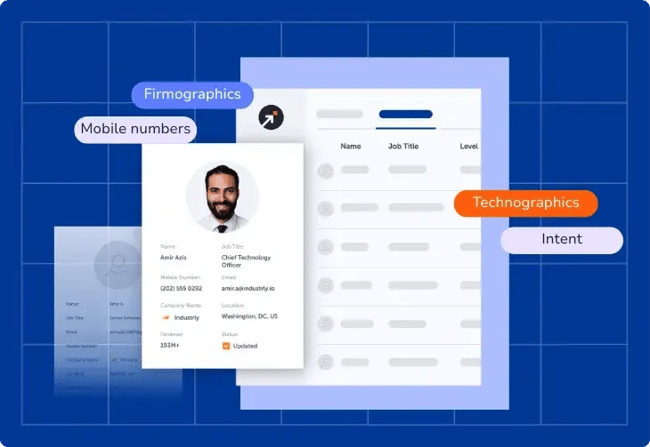
Best for: Accessing human-verified B2B contact data and intent-driven insights.
Finding leads is one thing, but getting accurate, up-to-date contact details is another challenge entirely. Outdated emails, disconnected phone numbers, and missing decision-maker info can stall even the best sales strategies. That’s where SalesIntel stands out.
SalesIntel ensures your prospecting efforts are fueled by 95% accurate, human-verified B2B data. Whether you need direct dials, mobile numbers, or intent signals, SalesIntel gives you a complete picture of your ideal prospects. So you’re always reaching out at the right time, with the right message. From technographic and firmographic insights to VisitorIntel, which identifies anonymous website visitors, SalesIntel provides the tools to turn raw data into real opportunities.
Key Features and Benefits
- Human-Verified Contact Data: Every email and phone number is manually verified to ensure accuracy.
- Intent Data & Intent Automation: Identify prospects actively searching for solutions like yours.
- Mobile & Direct Dials: Reach decision-makers directly without navigating gatekeepers.
- RevDriver Chrome Extension: Pull verified contact details from LinkedIn and company websites instantly.
- VisitorIntel & AdsIntel: Uncover site visitors and run targeted ad campaigns to stay top-of-mind.
10. Gong
Pricing: Contact for pricing
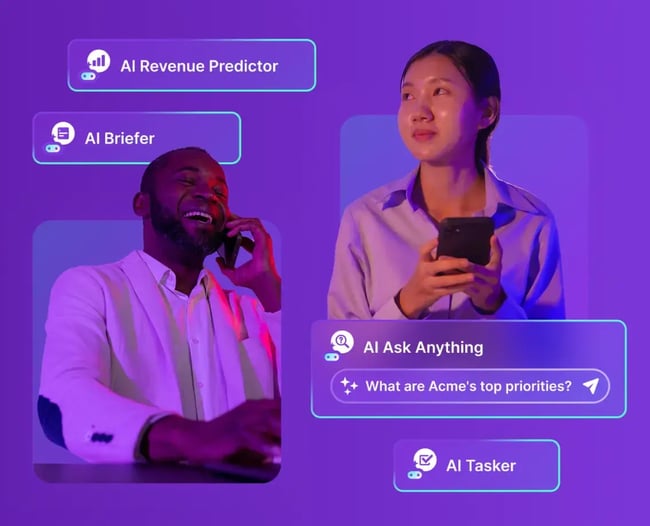
Best for: Improving outreach efforts via coaching reps.
Gong might be the most prominent conversation intelligence platform on the market. It’s a powerful solution that boasts an impressive list of customers, including LinkedIn, Zillow, and Okta — and for good reason. The platform is dynamic, intuitive, and can enhance virtually every aspect of your sales process.
This solution offers a range of sales-call-related features, but its support for more targeted call coaching is especially powerful for improving sales organizations’ prospecting efforts.
Gong gives sales managers access to recordings, transcripts, and other data to help them zero in on where reps are struggling when conducting outreach. All of that information can also expose other flaws and inefficiencies in elements of a sales org’s prospecting efforts, such as its call cadence or sales messaging.
All told, Gong is one of the most effective, accessible resources a sales org can leverage to ensure its phone outreach is first-rate and help reps prospect more thoughtfully.
Key Features and Benefits
- Guided workflows to help you establish repeatable processes for better-targeted call coaching.
- Visible transcripts for focused call analysis.
- An impressive suite of integrations — including HubSpot, Salesforce, and Slack.
11. Sopro
Pricing: Paid Plans start at £3,000/month
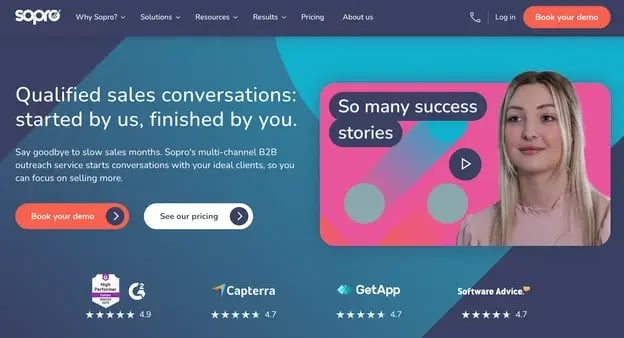
Best for: Businesses that need a fully managed prospecting service for B2B sales teams.
Sopro’s fully managed prospecting service is for B2B sales teams that don’t have the time or resources to run outreach themselves. They combine expert strategy, live data sourcing, and multi-channel engagement.Rather than tying up sales reps with prospecting admin, Sopro takes care of the entire process. A dedicated team tailors, delivers, and refines campaigns so sales reps can stay focused on selling. Sopro has a client portal for live reporting and is fully integrated with HubSpot. Verifies and cleans email lists with 99% accuracy.
Key Features and Benefits
- Dedicated outreach experts managing your entire campaign
- Access to the tech, tools, and data of a leading B2B agency
- Multi-channel campaigns and transparent performance tracking
12. VerifiedEmail
Pricing: Free trial, paid plans available
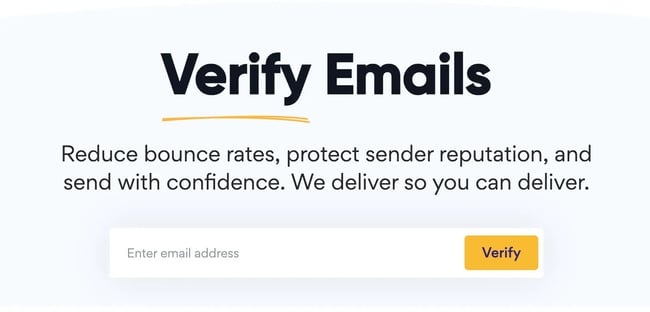
Best for: Real-time email list verification and cleaning.
VerifiedEmail helps sales teams avoid wasting time and money on invalid leads by checking email addresses in real-time with 99% accuracy — so your campaigns hit real, active inboxes. Its proprietary technology quickly identifies invalid or disposable emails, spots role-based addresses (like info@, sales@) for targeted outreach, and removes duplicates — improving deliverability and reducing bounce rates.
You can use its user-friendly widget directly on your website to validate emails as users sign up, or integrate it into your existing sales workflow through its API — connecting with HubSpot, Zapier, Klaviyo, and more.
Key Features and Benefits
- Verifies and cleans email lists with 99% accuracy.
- Identifies role-based emails for improved prospect targeting.
- Provides real-time verification at lead capture (widget).
- Simple API integration with HubSpot, Zapier, Klaviyo, and others.
13. Lusha
Pricing: Free plans available
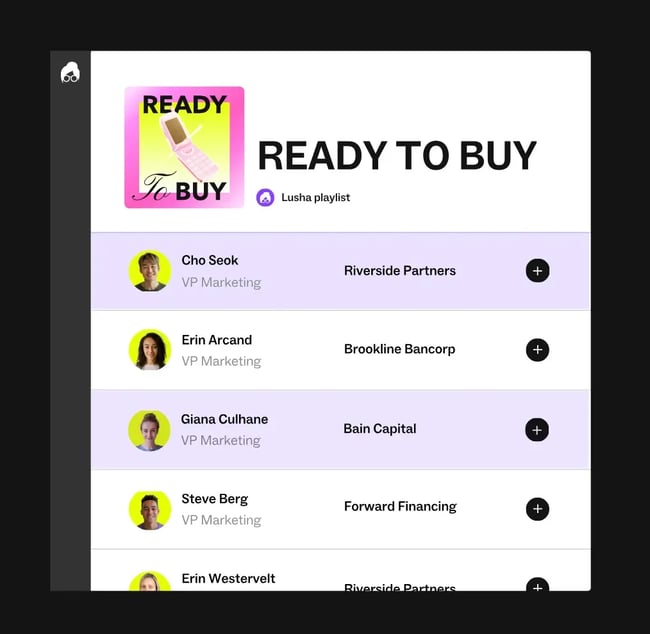
Best for: Easily sourcing and accessing prospects’ contact information.
Lusha is a first-rate data enrichment resource for finding prospects’ contact information, including both email addresses and phone numbers. This solution allows you to easily and reliably connect with decision-makers and other key contacts at a range of businesses.
The program’s “contact search” feature provides as many as 1,000 contacts — supported by enriched data — in a single search. It also lets you pull up millions of potential prospects’ direct dials.
From there, the software lets you convert those searches into focused, clean, exportable contact lists. Plus, all of these features come in a straightforward yet powerful interface that’s easy for anyone to use.
Key Features and Benefits
- Robust “contact search” function.
- Similarly thorough “company search” function.
- Extensive suite of integrations, including HubSpot, Salesforce, and Gmail.
14. Datanyze
Pricing: Free plans are available
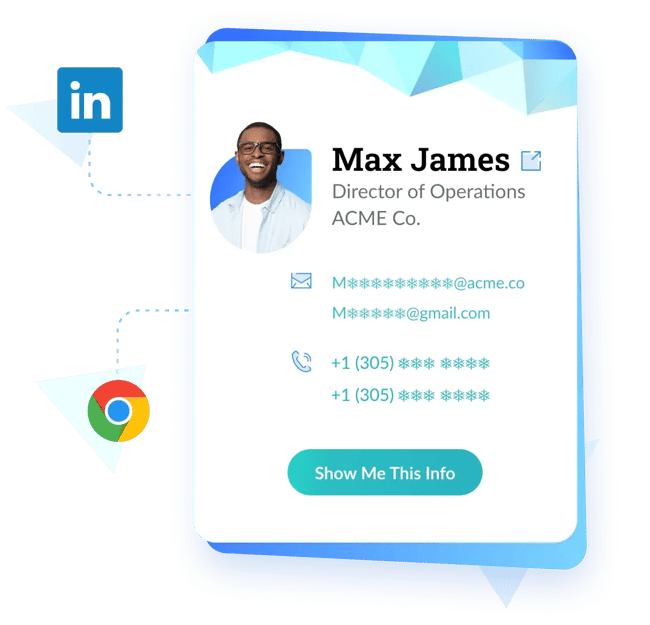
Best for: Conversationally connecting with prospects.
Datanyze is an intuitive Google Chrome extension that allows salespeople to easily access B2B contact information and other valuable prospect data, including email addresses, direct dial numbers, and company details.
In addition, Datanyze really sets itself apart with its personalization. The program leverages automated machine learning to support one of the most detailed B2B databases on the Internet — and that degree of detail doesn’t go to waste.
Datanyze then uses that insight to structure relevant icebreakers for individual prospects: unique conversation starters informed by data from sources like prospects’ social media feeds and local news publications.
Key Features and Benefits
- A robust, detailed B2B contact library.
- Easily integratable (so long as you have Google Chrome).
- Generates specific, effective icebreakers for prospect outreach.
15. Ring.io
Pricing: Ring.io costs $89 per user/month for HubSpot integration
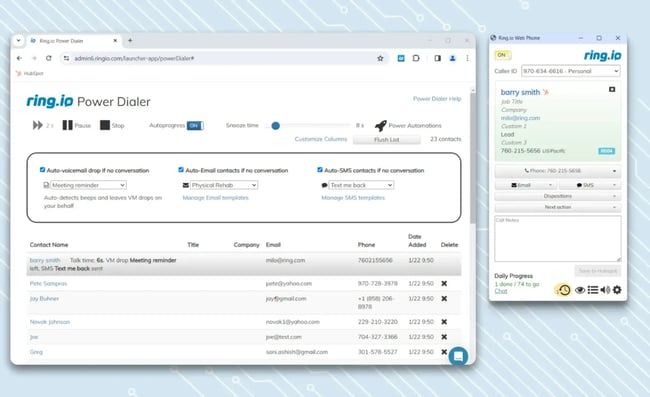
Best for: Improving sales call productivity.
Ring.io is a sales dialing solution that streamlines your team’s sales call process and improves your org’s sales call volume (without sacrificing productivity). It allows your reps to dial directly out of your CRM, easily and reliably connecting them with the right prospects.
The program also includes features like automated local caller ID and automatic pre-recorded voicemails — making your prospect outreach more efficient, personalized, and approachable.
Leveraging Ring.io also lets you shape and refine an effective call cadence, and the software accommodates even the longest of leads lists. Taken together, Ring.io’s many features can help you achieve wider-reaching, more productive sales calls.
Key Features and Benefits
- Direct dialing out of your CRM.
- Automated local caller ID to improve connect rates.
- Automated pre-recorded voicemails for prospects you miss.
Featured Resource: Prospecting and Objection Handling
Now, let’s take a step back and look at the sales prospecting process as a whole.
Sales Prospecting Process
If prospecting is the spark, the process is the engine. You can’t rely on random acts of outreach and expect predictable revenue. Over the years, I’ve learned that the difference between inconsistent results and a reliable sales pipeline comes down to having a clear, repeatable structure — one that adapts to the buyer, not just the playbook. Here’s how I approach it.
1. Research
This is where the real work begins, not with a pitch, but with curiosity. I don’t treat research as a box to check; I treat it as my competitive edge. Because the moment I understand why a company exists, how they operate, and what their current pain points are, I stop sounding like a seller and start speaking their language.
For me, research isn’t just about LinkedIn titles or company size. It’s about finding buying signals. Are they hiring for roles I solve? Have they raised a round of funding? Did their leadership just change? I dig through recent press releases, browse their product pages, scan Glassdoor for culture clues, and always check if they’re mentioned on industry podcasts or review sites.
I want to know:
- Are they actively solving the problem I address?
- Do they have a strategic reason to care now?
- And can I confidently say, “This is someone I can help”?
If I can’t answer those three questions after five minutes of research, they’re not ready, or I’m not ready to reach out. Either way, it’s a no-go until I’ve got enough context to bring value from the very first line.
2. Outreach
Here’s where most reps start getting nervous, but I see outreach as the part where all the prep finally pays off. If research is about clarity, outreach is about momentum. I don’t just hit send and hope. I treat every message — whether it’s a cold email, LinkedIn DM, or a well-timed call — as a chance to start a conversation, not push a product.
When I reach out, my first goal is simple: earn a response. That means I need to sound human, relevant, and respectful of their time. So I ditch the robotic intros and canned openers. Instead, I start with something real, an insight from their company blog, a shift in their org chart, or even a recent quote from their CEO. Something that says, I did my homework.
I also try to predict the path of resistance. In most B2B orgs, your first point of contact won’t be the decision-maker, it’ll be someone managing the calendar or filtering messages. And honestly? That’s okay. I treat gatekeepers with the same respect I give execs, because I’ve seen how often a good first impression turns into a warm intro.
Once I get to the right person, I don’t pitch. I probe. My best-performing emails and calls start with a problem I believe they’re already thinking about, and then offer to explore whether I can help. No pressure. Just alignment.
And I always track it all. Every touchpoint gets logged in the CRM, not just to stay organized but to see what patterns emerge. Which subject lines convert? Which CTAs get clicks? Which buyers prefer voice over email?
Great outreach isn’t just about what you say. It’s about when, how, and why you say it.
3. Discovery Call
For me, the discovery call isn’t just another checkbox in the prospecting process; it’s the turning point. It’s where the theory meets reality. At this stage, I’m not pitching. I’m listening. My goal? To understand the prospect’s world better than they expect me to.
When I hop on a discovery call, I already know the basics: their company, role, and recent initiatives. But I use the first five minutes to test my assumptions, and more importantly, to create space for them to talk. I ask open-ended questions that don’t just probe pain points, but uncover priorities, hidden blockers, and what’s truly at stake for their team.
A good discovery call is never a script. It’s a dance. One where curiosity drives the tempo and empathy sets the tone.
I’ve learned that the most powerful thing I can do on that first call is make them feel understood. Not sold to, not cornered — just heard. When I reflect back what I’ve learned, “It sounds like your team’s stuck between scaling demand and maintaining data quality,” I’m showing I’m not just here to close, I’m here to contribute.
This is also where I begin to qualify not just the opportunity, but the partnership. Are they a fit for what we offer? Are we aligned on goals and mindset? That clarity only comes when I stop treating discovery as an interrogation and start treating it as a mutual evaluation.
Here’s something I live by: The more tailored my questions, the more valuable the answers. That’s how I move the conversation from generic interest to meaningful urgency. Because once the prospect feels like I “get it,” I’m not just another seller. They see me as someone worth calling back.
4. Educate and Evaluate
At this stage in the prospecting journey, I’m not just qualifying the deal: I’m helping the buyer qualify me. What I do after the discovery call is where deals begin to take real shape. This is where I shift from active listening to active alignment.
By now, I’ve gathered context. I understand their structure, roadblocks, and desired outcomes. Now it’s time to connect the dots between their pain and my solution, without turning it into a one-sided pitch. That means educating them on what’s possible, not just what’s for sale.
When I walk into this part of the process, I use the insights from the call to frame two key conversations: the real pain points they’re trying to solve, and the objections that might stop them from solving them with us.
Pain Points
I don’t settle for surface-level pain. I look for the cost of inaction. If a team is losing 40 hours a month to manual data cleanup, I don’t just note it. I translate that into dollars, burnout, and missed targets. It’s not about showing what my product does; it’s about showing what not using it will cost them.
When I’m educating a prospect, I’m not dumping feature lists. I’m telling a story where they’re the hero, and our solution is the tool that helps them win. It has to be specific. If I’m talking to a RevOps lead at a B2B SaaS company, I’ll reference lagging pipeline velocity, broken attribution, and why their sales-marketing alignment is suffering. That’s when they lean in.
I’ve found that the most impactful sales conversations happen when the prospect starts saying, “That’s exactly what we’ve been struggling with.” That’s when you know you’re speaking their language.
Objections
But even with clear pain and strong interest, there’s always friction. Budget pushback, timing hesitations, competing priorities. That’s why I treat objections as buying signals, not roadblocks. If someone is objecting, they’re engaging. My job is to show them I’ve heard this before, and I’ve solved it before.
Instead of rushing to defend my product, I step back and ask, “What’s giving you pause?” That unlocks truth. Sometimes it’s internal buy-in, sometimes it’s fear of implementation chaos. But unless I know what’s underneath the surface, I can’t address it with confidence.
This is also when I evaluate whether we’re truly the right partner. I’ll walk away from a deal if I see a mismatch in timing, values, or expectations. Long-term trust matters more than short-term quota.
In the end, educate and evaluate isn’t about “convincing.” It’s about helping the buyer make a smart decision, and making sure that decision includes you for the right reasons.
5. Close
By the time you reach this step, the cards are on the table. You’ve surfaced the real pain, handled objections, and confirmed there’s a mutual fit. Now, it’s about guiding the prospect toward a clear decision: Are we moving forward or parting ways for now?
In my experience, closing isn’t about pressure or slick talk. It’s about clarity, timing, and trust. You’ve done the hard work upfront: personalized outreach, value-driven discovery, relevant follow-ups. So when it’s time to close, your ask should feel like a natural next step, not a leap.
Here’s how I approach it. I recap the agreed value, confirm their internal buying process, and set a short deadline for the next action. For example: “Based on what you shared about [pain point], and how [our solution] addresses that, are you ready to move forward this week?” This kind of framing makes it easier for the buyer to say yes or to flag any final blockers early.
And no matter the outcome (closed-won or closed-lost), I track every result. Your close rate tells the truth about how well your prospecting is working. If I notice a pattern in lost deals, I revisit my discovery. If deals are stuck in limbo, I check for gaps in urgency or stakeholder alignment.
The close is not the end of the prospecting journey. It’s the validation of everything that came before. Done right, it sets the tone not just for revenue, but for long-term relationships.
Outbound vs. Inbound Prospecting
The field of sales is constantly evolving. Sales reps no longer have to choose between inbound or outbound prospecting. Now, they have the flexibility to incorporate elements of both into their efforts.
Outbound prospecting is when you reach out to leads who haven’t yet expressed an interest in your product or business. You typically identify prospects through independent research, whether by finding them on LinkedIn, Googling them, or using another platform.
Inbound prospecting is when you reach out to a lead who has already shown an active interest in your business or product. Perhaps they’ve visited your website, subscribed to your blog, or maybe even submitted a form asking to speak to a sales rep. You then engage with them to understand whether they’d be a good fit for your product.
Here are the key differences between the two methodologies:
Outbound Prospecting | Inbound Prospecting | |
Outreach | Cold calling or emailing — unsolicited calls to sell your product or service | Warm emails to explore a relationship with a lead who has already expressed familiarity with your product or service |
Social “spamming” | Unsolicited social media messages to sell your product or service | Use social media to explore a relationship with a lead who has already expressed familiarity with your product or service; you can provide value to prospects on social media by answering their questions and introducing them to useful content |
Process | Research takes longer without any prior history with a contact, meaning you have less context when you’re ready to reach out to establish a connection | Research process is shorter as you already have their contact information and interaction history, providing you with context about the prospect’s interests or prior behavior and allowing you to develop more personalized outreach |
Example | “Hi John, I wanted to reach out to you because I’ve worked with companies similar to yours in the past.” | “Hi John, I’m reaching out because I noticed you were looking at our e-book on improving sales productivity.” |
My recommendation? Lean mostly on the inbound methodology when you prospect, but still include a responsible approach to outbound tactics like cold calling and cold emailing. Especially for businesses that don’t have enough qualified inbound leads, outbound can be an important component of the process.
But regardless of whether you’re focused on outbound or inbound, it’s critical to make sure you’re helping the buyer (rather than selling to them), leveraging their context and understanding who they are and what they need.
Of course, that’s easier said than done. How do you find prospective buyers and learn the context surrounding their business needs? Even more importantly, how do you determine whether or not you should begin the process of selling to them?
There’s no one-and-done answer, but asking the sales prospecting questions below can help you qualify prospects and focus on your highest-potential leads.
Sales Prospecting Questions
One of the biggest mistakes I see reps make is chasing every lead like it’s gold. But not every lead is a fit, and not every conversation is worth the time. In fact, I’ve learned the hard way that qualifying early and often is what separates consistent pipeline builders from calendar chasers.
In my process, I treat every prospecting conversation like a filter. I’m not just looking for interest, I’m looking for alignment. That means digging into the right questions before I go any further. Here’s how I qualify leads based on organizational fit, timing, and buying potential.
Is the prospect’s business an organizational fit?
I’ve learned that no matter how great your pitch is, if you’re talking to the wrong type of company, it doesn’t matter. That’s why my first filter in any prospecting motion is fit. Not interest. Not budget. Fit.
For me, organizational fit comes down to three core signals: structure, size, and stage. I’m asking: Does this company operate in the industries we’ve helped before? Are they using a similar tech stack to our top customers? Are they at a maturity level where our solution actually solves a pressing pain?
Let’s say I’m targeting Series A–C SaaS companies with 50 to 500 employees and a sales-led motion. If I stumble onto a bootstrapped agency with eight team members, I don’t try to force a conversation. That’s not a lead, it’s a distraction. And when you waste time on mismatched leads, you lose deals you could’ve won elsewhere.
I use this fit-first filter to prioritize accounts before I ever hit send on a cold email. Because high-fit prospects don’t just convert better, they stay longer. They’re easier to onboard. They advocate for you inside their company. And they unlock expansion faster.
Bottom line: Fit isn’t just a checkbox. It’s the multiplier that makes the rest of your prospecting work worth it. If you get this wrong, everything downstream suffers.
Have you identified key stakeholders?
One of the biggest mistakes I made early in my sales career was stopping at the first “yes.” I’d get a promising reply, hop on a call, and assume I was talking to the decision-maker. Weeks later, I’d hear, “We just need leadership approval,” and realize I was never talking to the real buyer in the first place. That’s when I learned that identifying stakeholders isn’t optional. It’s foundational.
In my current workflow, I separate stakeholders into two camps: influencers and decision-makers. Influencers are usually the end users, the ones who feel the pain most directly. They’re often the first to engage, and if you build trust early, they’ll champion your solution internally. But they usually don’t control the budget.
Decision-makers care less about features and more about outcomes. They look at ROI, business alignment, and potential risks. If I don’t get them involved early, deals tend to stall. So when I’m prospecting, I map out the entire buying committee before I even write my first email. I review LinkedIn roles, check company org charts, and dig into mutual connections who can help unlock access.
Here’s one simple question I ask on nearly every call: “Besides yourself, who else would need to be part of this conversation to move forward?” That one line has saved me from wasted cycles and helped me build buy-in from the start.
Takeaway: Prospecting isn’t just about opening a door. It’s about knowing exactly who’s behind it and how to earn their trust.
Are the prospect’s constraints a deal-breaker?
Before I schedule a deep-dive call, I run a quick “sanity check” on two variables: budget and bandwidth. If the numbers are not there, or if the team is knee-deep in a product launch, the smartest move is to park the deal for another quarter. I start with public signals: funding rounds, hiring freezes, marketing pushes. A fresh Series A usually means money is available, while a hiring pause often hints at tightening belts.
Next I probe time. Busy teams leave plenty of clues: packed event calendars, major releases, leadership transitions. If everything points to chaos, I send a brief note that offers value now, then ask for a better window to reconnect. I record these “not-now, maybe-later” leads in my CRM with a future task so they never slip through the cracks.
Bottom line: A fast reality check on money and timing protects your calendar from deals that cannot close today but positions you perfectly when the smoke clears tomorrow.
Are you familiar with the prospect’s market?
When I first started prospecting, I chased everything. Tech startup? Sure. Logistics provider? Why not. But what I learned the hard way is that if you don’t speak your buyer’s language, you’ll burn cycles and lose trust before the first call is over. That’s why now, before I reach out, I pause and ask: Do I actually understand their market?
This doesn’t mean becoming a subject matter expert in every niche. It means doing the legwork. I skim industry reports, check their competitor landscape, read a few customer reviews, and follow their CMO on LinkedIn. I want to know how they make money, what keeps them up at night, and how their world is shifting. That context lets me ditch generic pitches and speak with relevance from the very first message.
Takeaway: When you work in verticals you know well, your outreach becomes faster, sharper, and more natural. But even when a new market is unfamiliar, curiosity can bridge the gap. A well-timed insight or question rooted in their ecosystem hits way harder than a scripted one-size-fits-all pitch.
Would your company add substantial value?
This is where I slow down and get brutally honest. Just because I can pitch someone doesn’t mean I should. When I’m prospecting, one of the first things I ask myself is: Would working with us actually move the needle for them?
I’m not talking about surface-level benefits or fluffy features. I’m looking for real alignment, where our solution solves a core problem they’re actively trying to fix, or helps them hit a priority goal faster, cheaper, or with less friction. If I can’t see that clear value delta, I don’t waste their time or mine. And when I do see it, I make sure it’s baked into the pitch from the very first line.
Here’s how I qualify that value. I look at their current maturity, team size, tools, and timing. If they’re already crushing it in the area we serve, we’re probably not a high-leverage investment. But if there’s a visible gap we can fill, or a friction point we’re built to remove, that’s a green light.
Bottom line: Always put the customer first and evaluate if the value you offer is substantial enough to warrant their investment.
Do they have an awareness of your offering?
Before I reach out to any prospect, I like to pause and ask: Have they already heard of us? Because awareness isn’t just a nice-to-have, it’s often the difference between being ignored and getting a reply.
When a lead has visited your site, liked a post, clicked a webinar, or even just viewed your profile on LinkedIn, they’re already leaning in. That small signal tells me they’re at least curious, and curiosity is a door opener. On the flip side, if they’ve never interacted with our brand or content, I know I’m starting from scratch, which means I’ll have to educate before I sell.
That’s why I track and score awareness levels across all active prospects. Even something simple like “engaged vs cold” helps me prioritize where to spend my time. If someone’s downloaded a whitepaper or opened three emails, they’re more likely to respond to a direct value pitch. If not, I start with a softer touch, like offering a quick resource or asking a thoughtful question.
Takeaway: Before reaching out, be sure to know whether your lead is cold or warm.
Prospecting Email Examples
Once you’ve identified your prospects, it’s time to start connecting with them. Ready to reach out to some prospects? Use the following email templates to get started:
1. Reaching Out After a Referral
Subject: [Name of referrer] recommended we connect
Hey [prospect name],
It’s great to meet you. Our mutual connection, [name of referrer], recommended I get in contact with you because [X].
I would love to hear more about what you do in your role — according to [name of referrer], it seems like you may be facing [X] challenges.
[Product name] can help you achieve [X] and increase efficiency by [X]%.
Is that a priority for your team right now?
Best,
[Your name]
2. Providing Links After They Downloaded a Resource
Subject: More [specialty] resources for [business name]
Hi [prospect name],
It’s great to meet you. How are you enjoying [name of resource] so far?
I can see that you’re interested in [X], and so I compiled three more resources that will help your team do [X] better.
- [Link 1]
- [Link 2]
- [Link 3]
In the meantime, I’d love to hop on a phone call and learn about how your quarter is going so far. Are you available on Thursday morning for a 10-minute call?
Best,
[Your name]
3. Congratulating Them for an Award or Publication
Subject: Congrats on [award]
Hi [prospect name],
Congratulations on receiving [award]! That’s a rare accomplishment — kudos to you and the team.
To introduce myself, I’m a [title] at [company]. I work with small businesses in your industry to achieve [X] results. Just last week, [competitor] told me they finally reached their goal of [X], boosting their ROI to [X]%.
I’d love to chat and see whether we can get similar, if not better, results for you. Would you be available for a ten-minute call on Friday?
Best,
[Your name]
Prospect Marketing
Prospect marketing is a brand of content marketing a business leverages deeper in its sales process than most other types of marketing. It involves providing a prospect with media like sales collateral, technical documents, and other resources to help influence their decision-making as they move closer to closing.
So, you’ve successfully prospected a handful of potential clients. Now what? It’s time to nurture those prospects with prospect marketing.
Prospect marketing is essentially bringing a prospect closer to, well, closing. Just because you’ve connected with a prospect doesn’t mean you should stop all your marketing efforts. Instead, your marketing should become more personalized and targeted.
If you haven’t already developed sales collateral, work with your marketing and customer service teams to prepare these materials for potential buyers in each stage of their journey. Email templates, call scripts, and pre-call checklists are just a few of the tools I’d suggest to help you streamline the prospect marketing process.
Another prospect marketing strategy is creating workflows in tools like HubSpot. Workflows automate your marketing processes — including how you market to your prospects.
Use workflows to set up pre-written emails, SMS messages, or in-app notifications that are sent to your prospects based on certain triggers, such as a video view, a content offer download, or inactivity for a certain number of days.
In short, anything that keeps your prospects engaged with and educated about your brand is considered prospect marketing. Even a daily or weekly check-in with prospects counts. Again, just because you’ve connected with a prospect doesn’t mean the marketing should stop.
Begin Sales Prospecting
Prospecting doesn’t have to feel like cold calling in a snowstorm. If you approach it with the right mindset and rhythm, it becomes less about pressure and more about precision.
I’ve learned that momentum builds fast once you take the first step. The hardest part is often just getting started. Don’t wait until your pipeline runs dry. Block time on your calendar, pull up your research, and choose the first person worth helping. That’s the key. Don’t think about “closing,” think about earning trust, one message at a time.
Try one or two new strategies from this post. Test a different subject line, record a quick Loom video, call someone who clicked your email twice but didn’t reply. Prospecting works when you treat it like a craft, not a chore.
If you commit to showing up consistently and refining your process along the way, you won’t just generate more leads. You’ll also become the rep buyers want to talk to.
So take a breath, open your CRM, and start. The right prospects are out there. They just haven’t heard from you yet.
Editor’s note: This post was originally published in May 2018 and has been updated for comprehensiveness.
![]()



Leave a Reply